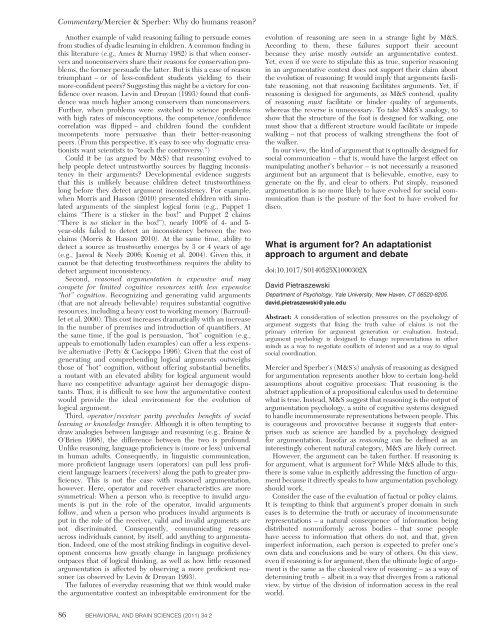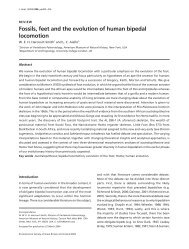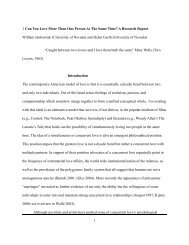Commentary/Mercier & Sperber: <strong>Why</strong> <strong>do</strong> <strong>hum<strong>an</strong>s</strong> <strong>reason</strong>?Another example of valid <strong>reason</strong>ing failing to persuade comesfrom studies of dyadic learning in children. A common finding inthis literature (e.g., Ames & Murray 1982) is that when conservers<strong>an</strong>d nonconservers share their <strong>reason</strong>s <strong>for</strong> conservation problems,the <strong>for</strong>mer persuade the latter. But is this a case of <strong>reason</strong>triumph<strong>an</strong>t – or of less-confident students yielding to theirmore-confident peers? Suggesting this might be a victory <strong>for</strong> confidenceover <strong>reason</strong>, Levin <strong>an</strong>d Druy<strong>an</strong> (1993) found that confidencewas much higher among conservers th<strong>an</strong> nonconservers.Further, when problems were switched to science problemswith high rates of misconceptions, the competence/confidencecorrelation was flipped – <strong>an</strong>d children found the confidentincompetents more persuasive th<strong>an</strong> their better-<strong>reason</strong>ingpeers. (From this perspective, it’s easy to see why <strong>do</strong>gmatic creationistsw<strong>an</strong>t scientists to “teach the controversy.”)Could it be (as argued by M&S) that <strong>reason</strong>ing evolved tohelp people detect untrustworthy sources by flagging inconsistencyin their arguments? Developmental evidence suggeststhat this is unlikely because children detect trustworthinesslong be<strong>for</strong>e they detect argument inconsistency. For example,when Morris <strong>an</strong>d Hasson (2010) presented children with simulatedarguments of the simplest logical <strong>for</strong>m (e.g., Puppet 1claims “There is a sticker in the box!” <strong>an</strong>d Puppet 2 claims“There is no sticker in the box!”), nearly 100% of 4- <strong>an</strong>d 5-year-olds failed to detect <strong>an</strong> inconsistency between the twoclaims (Morris & Hasson 2010). At the same time, ability todetect a source as trustworthy emerges by 3 or 4 years of age(e.g., Jaswal & Neely 2006; Koenig et al. 2004). Given this, itc<strong>an</strong>not be that detecting trustworthiness requires the ability todetect argument inconsistency.Second, <strong>reason</strong>ed argumentation is expensive <strong>an</strong>d maycompete <strong>for</strong> limited cognitive resources with less expensive“hot” cognition. Recognizing <strong>an</strong>d generating valid arguments(that are not already believable) requires subst<strong>an</strong>tial cognitiveresources, including a heavy cost to working memory (Barrouilletet al. 2000). This cost increases dramatically with <strong>an</strong> increasein the number of premises <strong>an</strong>d introduction of qu<strong>an</strong>tifiers. Atthe same time, if the goal is persuasion, “hot” cognition (e.g.,appeals to emotionally laden examples) c<strong>an</strong> offer a less expensivealternative (Petty & Cacioppo 1996). Given that the cost ofgenerating <strong>an</strong>d comprehending logical arguments outweighsthose of “hot” cognition, without offering subst<strong>an</strong>tial benefits,a mut<strong>an</strong>t with <strong>an</strong> elevated ability <strong>for</strong> logical argument wouldhave no competitive adv<strong>an</strong>tage against her demagogic disput<strong>an</strong>ts.Thus, it is difficult to see how the <strong>argumentative</strong> contextwould provide the ideal environment <strong>for</strong> the evolution oflogical argument.Third, operator/receiver parity precludes benefits of sociallearning or knowledge tr<strong>an</strong>sfer. Although it is often tempting todraw <strong>an</strong>alogies between l<strong>an</strong>guage <strong>an</strong>d <strong>reason</strong>ing (e.g., Braine &O’Brien 1998), the difference between the two is profound.Unlike <strong>reason</strong>ing, l<strong>an</strong>guage proficiency is (more or less) universalin hum<strong>an</strong> adults. Consequently, in linguistic communication,more proficient l<strong>an</strong>guage users (operators) c<strong>an</strong> pull less proficientl<strong>an</strong>guage learners (receivers) along the path to greater proficiency.This is not the case with <strong>reason</strong>ed argumentation,however. Here, operator <strong>an</strong>d receiver characteristics are moresymmetrical: When a person who is receptive to invalid argumentsis put in the role of the operator, invalid argumentsfollow, <strong>an</strong>d when a person who produces invalid arguments isput in the role of the receiver, valid <strong>an</strong>d invalid arguments arenot discriminated. Consequently, communicating <strong>reason</strong>sacross individuals c<strong>an</strong>not, by itself, add <strong>an</strong>ything to argumentation.Indeed, one of the most striking findings in cognitive developmentconcerns how greatly ch<strong>an</strong>ge in l<strong>an</strong>guage proficiencyoutpaces that of logical thinking, as well as how little <strong>reason</strong>edargumentation is affected by observing a more proficient <strong>reason</strong>er(as observed by Levin & Druy<strong>an</strong> 1993).The failures of everyday <strong>reason</strong>ing that we think would makethe <strong>argumentative</strong> context <strong>an</strong> inhospitable environment <strong>for</strong> theevolution of <strong>reason</strong>ing are seen in a str<strong>an</strong>ge light by M&S.According to them, these failures support their accountbecause they arise mostly outside <strong>an</strong> <strong>argumentative</strong> context.Yet, even if we were to stipulate this as true, superior <strong>reason</strong>ingin <strong>an</strong> <strong>argumentative</strong> context <strong>do</strong>es not support their claim aboutthe evolution of <strong>reason</strong>ing: It would imply that arguments facilitate<strong>reason</strong>ing, not that <strong>reason</strong>ing facilitates arguments. Yet, if<strong>reason</strong>ing is designed <strong>for</strong> arguments, as M&S contend, qualityof <strong>reason</strong>ing must facilitate or hinder quality of arguments,whereas the reverse is unnecessary. To take M&S’s <strong>an</strong>alogy, toshow that the structure of the foot is designed <strong>for</strong> walking, onemust show that a different structure would facilitate or impedewalking – not that process of walking strengthens the foot ofthe walker.In our view, the kind of argument that is optimally designed <strong>for</strong>social communication – that is, would have the largest effect onm<strong>an</strong>ipulating <strong>an</strong>other’s behavior – is not necessarily a <strong>reason</strong>edargument but <strong>an</strong> argument that is believable, emotive, easy togenerate on the fly, <strong>an</strong>d clear to others. Put simply, <strong>reason</strong>edargumentation is no more likely to have evolved <strong>for</strong> social communicationth<strong>an</strong> is the posture of the foot to have evolved <strong>for</strong>disco.What is argument <strong>for</strong>? An adaptationistapproach to argument <strong>an</strong>d debate<strong>do</strong>i:10.1017/S0140525X1000302XDavid PietraszewskiDepartment of Psychology, Yale University, New Haven, CT 06520-8205.david.pietraszewski@yale.eduAbstract: A consideration of selection pressures on the psychology ofargument suggests that fixing the truth value of claims is not theprimary criterion <strong>for</strong> argument generation or evaluation. Instead,argument psychology is designed to ch<strong>an</strong>ge representations in otherminds as a way to negotiate conflicts of interest <strong>an</strong>d as a way to signalsocial coordination.Mercier <strong>an</strong>d Sperber’s (M&S’s) <strong>an</strong>alysis of <strong>reason</strong>ing as designed<strong>for</strong> argumentation represents <strong>an</strong>other blow to certain long-heldassumptions about cognitive processes: That <strong>reason</strong>ing is theabstract application of a propositional calculus used to determinewhat is true. Instead, M&S suggest that <strong>reason</strong>ing is the output ofargumentation psychology, a suite of cognitive systems designedto h<strong>an</strong>dle incommensurate representations between people. Thisis courageous <strong>an</strong>d provocative because it suggests that enterprisessuch as science are h<strong>an</strong>dled by a psychology designed<strong>for</strong> argumentation. Insofar as <strong>reason</strong>ing c<strong>an</strong> be defined as <strong>an</strong>interestingly coherent natural category, M&S are likely correct.However, the argument c<strong>an</strong> be taken further. If <strong>reason</strong>ing is<strong>for</strong> argument, what is argument <strong>for</strong>? While M&S allude to this,there is some value in explicitly addressing the function of argumentbecause it directly speaks to how argumentation psychologyshould work.Consider the case of the evaluation of factual or policy claims.It is tempting to think that argument’s proper <strong>do</strong>main in suchcases is to determine the truth or accuracy of incommensuraterepresentations – a natural consequence of in<strong>for</strong>mation beingdistributed nonuni<strong>for</strong>mly across bodies – that some peoplehave access to in<strong>for</strong>mation that others <strong>do</strong> not, <strong>an</strong>d that, givenimperfect in<strong>for</strong>mation, each person is expected to prefer one’sown data <strong>an</strong>d conclusions <strong>an</strong>d be wary of others. On this view,even if <strong>reason</strong>ing is <strong>for</strong> argument, then the ultimate logic of argumentis the same as the classical view of <strong>reason</strong>ing – as a way ofdetermining truth – albeit in a way that diverges from a rationalview, by virtue of the division of in<strong>for</strong>mation access in the realworld.86 BEHAVIORAL AND BRAIN SCIENCES (2011) 34:2
Commentary/Mercier & Sperber: <strong>Why</strong> <strong>do</strong> <strong>hum<strong>an</strong>s</strong> <strong>reason</strong>?However, a consideration of the selection pressures <strong>for</strong> argumentsuggests that this is not a complete picture of the functionof argument <strong>an</strong>d thus not a complete picture of the psychology ofargumentation, even when dealing with claims ostensibly abouttruth. Here’s why.Communication exists because it affects behavior. This makescommunicated in<strong>for</strong>mation a particularly powerful way to leverageothers’ capacities. This creates opportunity <strong>for</strong> collaboration,as well as exploitation, <strong>an</strong>d as such there will be selection on bothsenders <strong>an</strong>d receivers of argument. M&S <strong>do</strong> not ignore that conflictof interest is inherent in communication – suggesting theexistence of epistemic vigil<strong>an</strong>ce <strong>for</strong> ensuring that only “reliable,”“effective,” “quality” in<strong>for</strong>mation is acted on. But what constitutesreliable, effective, or quality in<strong>for</strong>mation? Certainly, asM&S imply, a criterion of accuracy applies to a class of claims.“The bear is on this side of the river” <strong>an</strong>d “The bear is on theother side of the river” are factual claims warr<strong>an</strong>ting investigationof truth value. The bear is somewhere, after all, <strong>an</strong>d argumentwill help determine where.However, while there is <strong>reason</strong> to think that there is strongselection <strong>for</strong> discovering the accuracy <strong>for</strong> certain classes ofclaims, there is also good <strong>reason</strong> to think that there is little selection<strong>for</strong> searching <strong>for</strong> the accuracy of m<strong>an</strong>y others. Instead, ifsignaled in<strong>for</strong>mation is capable of causing others to act, thereis selection to broadcast representations that will cause othersto modify their current or future actions with respect to thesender. Because utility <strong>an</strong>d accuracy are ultimately separable,even <strong>for</strong> factual claims, there is not always selection <strong>for</strong> accuracy,but instead <strong>for</strong> a psychology that fixes representations –in oneself <strong>an</strong>d in others – along actuarially beneficialdimensions.This suggests at least two broad classes of selection pressures<strong>an</strong>d, subsequently, two broad classes of argument psychology:First, is a class of argumentation psychology designed toh<strong>an</strong>dle conflicts of interest over self-regarding <strong>an</strong>d other-regardingbehaviors, the goal of which is to ch<strong>an</strong>ge representations ofthe payoff structure of pursuing certain future pl<strong>an</strong>s. This viewof argument has already uncovered a highly-specific “grammar”of argument structure in both senders <strong>an</strong>d receivers (Petersenet al. 2010; Sell 2006; Tooby et al. 2008).Second, is a class of argumentation psychology designedaround social coordination. Because shared mental content is aconsequence of coordinated activities, <strong>an</strong>d because cooperationrequires a meeting of the “minds,” shared mental representationsc<strong>an</strong> be used as markers <strong>an</strong>d facilitators of social coordination. Inother words, the exposition of claims – <strong>an</strong>d the signal of agreementor disagreement with them – c<strong>an</strong> be used as a social instrumentto mark affiliation. Agreement <strong>an</strong>d disagreement there<strong>for</strong>ebecome commodities in themselves as a way of signaling thecoordination strength <strong>an</strong>d challenging others. This class of argumentationpsychology should be designed to conflate evaluationsof the argument with the source <strong>an</strong>d social context of the argument;who is arguing should be just as import<strong>an</strong>t as what theyare saying when considering the “goodness” of <strong>an</strong> argument.Additionally, the motivation to argue, <strong>an</strong>d the choice of argumentcontent itself, should be at least in part the result of strategic nonconsciousassessments of the local social world. This view of argumenthas already led to the discovery of evidence that the mindtreats certain classes of claims as markers of social affiliation (Pietraszewskiet al., in preparation).These are not aberr<strong>an</strong>t uses of argument, but, rather, thesefunctions lie at the core of how the hum<strong>an</strong> psychological competenceof argument – <strong>an</strong>d thus how “<strong>reason</strong>ing” – works. Thevaluation of social coordination, <strong>for</strong> example, is likely built rightinto the sinew <strong>an</strong>d bone of argumentation – both in terms ofthe criteria <strong>for</strong> generating arguments <strong>an</strong>d <strong>for</strong> the criteria of assessingargument. This suggests that <strong>reason</strong>ing is not simply base<strong>do</strong>n argument, but on argument designed <strong>for</strong> negotiating conflictsof interest <strong>an</strong>d signaling social coordination rather th<strong>an</strong> exclusivelyfixing truth.You c<strong>an</strong>’t have your hypothesis <strong>an</strong>d test it: Theimport<strong>an</strong>ce of utilities in theories of <strong>reason</strong>ing<strong>do</strong>i:10.1017/S0140525X10002980Fenna H. PoletiekDepartment of Psychology, Leiden University, The Netherl<strong>an</strong>ds.poletiek@fsw.leidenuniv.nlAbstract: Mercier <strong>an</strong>d Sperber’s (M&S’s) <strong>theory</strong> of <strong>reason</strong>ing c<strong>an</strong>notpredict <strong>reason</strong>ing in the absence of <strong>an</strong> <strong>argumentative</strong> context. Applyingthe <strong>theory</strong> to hypothesis testing behavior, I propose that hypothesistesting is often motivated by determining the true inference <strong>an</strong>d that<strong>reason</strong>ing models should account <strong>for</strong> utilities (affected by variousmotives, including the wish to convince) of <strong>reason</strong>ing outcomes.Mercier <strong>an</strong>d Sperber’s (M&S’s) <strong>argumentative</strong> <strong>theory</strong> of <strong>reason</strong>ing(ATR) claims that <strong>reason</strong>ing is aimed not at improving knowledge,but at persuading. According to ATR, <strong>an</strong> <strong>argumentative</strong>context (actual or proactive) is a necessary condition <strong>for</strong> <strong>reason</strong>ing<strong>an</strong>d <strong>reason</strong>ing is biased toward winning the argument. It willbe argued that the very logic of ATR is problematic <strong>an</strong>d that itc<strong>an</strong> not deal with a large majority of <strong>reason</strong>ing contexts inwhich agents (also) <strong>reason</strong> to determine a true or valid conclusion.I propose that a <strong>theory</strong> of <strong>reason</strong>ing should incorporateutilities of <strong>reason</strong>ing outcomes, to explain various motives <strong>for</strong><strong>reason</strong>ing, including <strong>argumentative</strong> motives.Although M&S discuss in detail the function of <strong>reason</strong>ing, it isnot always clear how <strong>reason</strong>ing is defined. If we assume <strong>reason</strong>ingto be about opinions <strong>an</strong>d preferences <strong>for</strong> which no normative st<strong>an</strong>dardis available, <strong>an</strong> <strong>argumentative</strong> view is quite straight<strong>for</strong>ward.People indeed may argue about political opinions <strong>an</strong>d preferenceswith no other goal th<strong>an</strong> to convince. However, if <strong>reason</strong>ing is thetreatment of in<strong>for</strong>mation about some (yet unknown) true or validinference, with the objective to reduce inference errors, then the<strong>argumentative</strong> <strong>theory</strong> is puzzling. Indeed, the ATR <strong>theory</strong> of<strong>reason</strong>ing disregards this inherent concern of approximating thevalid conclusion, going against what <strong>reason</strong>ing is defined to be.The uneasy coexistence of finding out the truth <strong>an</strong>d seeking confirmation<strong>for</strong> one’s belief in ATR is apparent in M&S’s <strong>an</strong>alysis of theconfirmation bias in hypothesis testing studies (Wason 1960). On theone h<strong>an</strong>d, M&S acknowledge, in line with classical critical <strong>an</strong>alyses ofthe confirmation bias (Klaym<strong>an</strong> & Ha 1987; Poletiek 1996; 2001;Wetherick 1962), that particip<strong>an</strong>ts’ behavior in these studies is notindicative of a biased search of supporting test outcomes, but thatit reflects a sound heuristic. Thisheuristicistestinghypotheseswith positive predictions. Using M&S’s example, suppose I believethat my keys are in my jacket because that is where I rememberputting them. I look <strong>for</strong> them in my jacket (positive testing) <strong>an</strong>dnot in my purse (negative testing). Hence, as opposed to theinterpretation of positive testing as a tendency to confirm (confirmationbias) (Cowley & Byrne 2005; Wason 1960), positive testingmay occur with no other goal th<strong>an</strong> finding out the truth, as thereal-life example suggests. According to ATR, positive testing is adefault heuristic that involves no <strong>reason</strong>ing proper.However, as M&S further argue, <strong>reason</strong>ing c<strong>an</strong> be triggered inhypothesis testing situations if <strong>an</strong> <strong>argumentative</strong> context is provided.Moreover, in such a context, <strong>reason</strong>ing is directed at falsification,according to ATR: Falsification is accessible provided that the situationencourages particip<strong>an</strong>ts to argue against a hypothesis that isnot their own, as M&S propose This logic reveals the old misinterpretationthat test choice (positive or negative) is tuned at the emergenceof favorable test result.Infact,puttingone’sideatoa(eitherpositive or negative) test assumes the objective to find out the truth<strong>an</strong>d is there<strong>for</strong>e at odds with testing in order to save our idea fromconfirmations or disconfirmations. Poletiek (1996) showed that particip<strong>an</strong>tsin a hypothesis testing experiment are aware of the incompatibilityof finding out the truth <strong>an</strong>d coming up with confirmingtest outcomes only. Particip<strong>an</strong>ts felt that they were looking <strong>for</strong> in<strong>for</strong>mationabout the validity of a hypothesis, <strong>an</strong>d that they could notcontrol the test outcomes by choosing a test strategy. It was onlyBEHAVIORAL AND BRAIN SCIENCES (2011) 34:2 87




